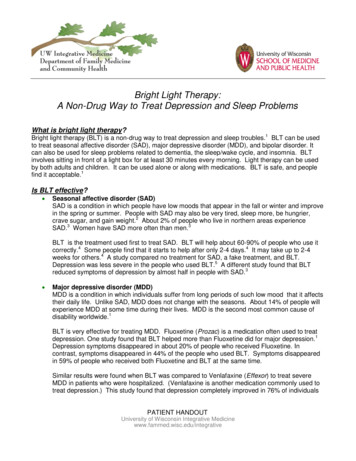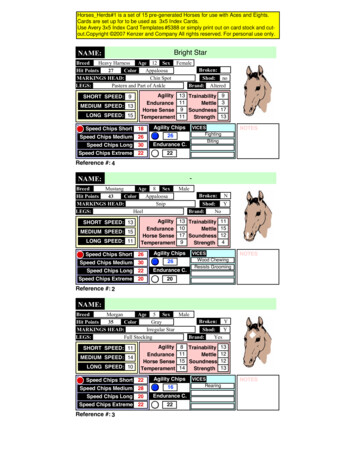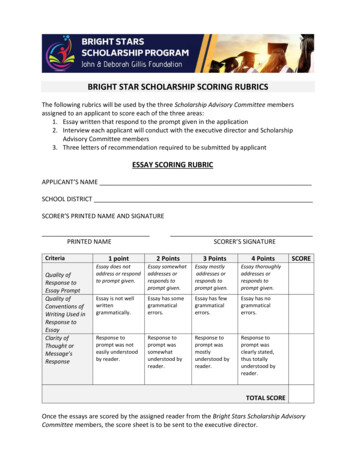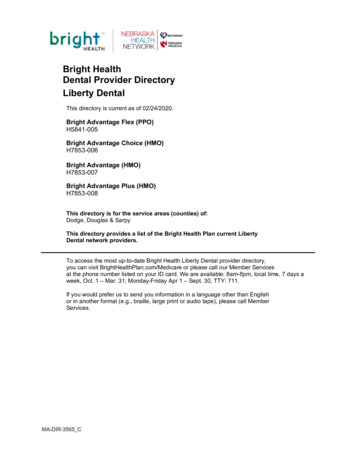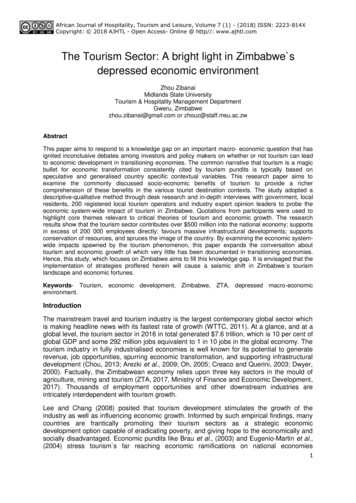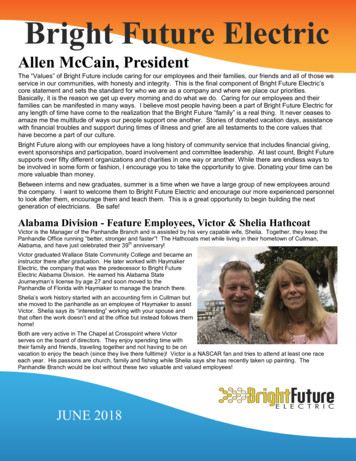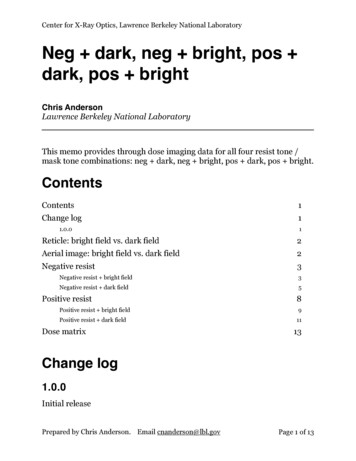
Transcription
Center for X-Ray Optics, Lawrence Berkeley National LaboratoryNeg dark, neg bright, pos dark, pos brightChris AndersonLawrence Berkeley National LaboratoryThis memo provides through dose imaging data for all four resist tone /mask tone combinations: neg dark, neg bright, pos dark, pos bright.ContentsContents1Change log11.0.01Reticle: bright field vs. dark field2Aerial image: bright field vs. dark field2Negative resist3Negative resist bright field3Negative resist dark field5Positive resist8Positive resist bright field9Positive resist dark field11Dose matrix13Change log1.0.0Initial releasePrepared by Chris Anderson. Email cnanderson@lbl.govPage 1! of !13
Center for X-Ray Optics, Lawrence Berkeley National LaboratoryReticle: bright field vs. dark fieldThe next figure depicts a bright field contact mask (left) and dark fieldcontact mask (right). Black is absorber. White is multilayer.Bright field 1:1 contactsDark field 1:1 contactsAerial image: bright field vs. dark fieldThe next figure depicts the aerial image cross-section from a bright fieldmask (left) and a dark field mask (right).Prepared by Chris Anderson. Email cnanderson@lbl.govPage !2 of !13
Center for X-Ray Optics, Lawrence Berkeley National LaboratoryAerial image from a bright field mask. Baseline isAerial image from a dark field mask. Baseline is“light everywhere” and light intensity drops in areas “no light everhwyere” and bright areas of light onlywhere absorber was on the mask.exist in places where the reflector was on themask.Negative resistNegative resist is rendered un-dissolvable anywhere the deposited energy is E0.Negative resist bright fieldThe following diagram depicts a developed wafer (bright field contacts negative resist) through the entire range of doses.Figure 1. Bright field mask with negative resist. Negative resist is rendered un-dissolvable anywherethe deposited energy is E0.The following image series shows printing results through dose for brightfield contacts with a negative resist.Prepared by Chris Anderson. Email cnanderson@lbl.govPage !3 of !13
Center for X-Ray Optics, Lawrence Berkeley National LaboratoryD1. In this image the light coloris negative resist rendered undissolvable during exposureD2.D3 As dose increases, negativeresist around the edges of thecontacts is rendered undissolvable and the hole patternstarts to emergeD4 Hole pattern evident.D5D6. More and more resist startsto fill in the holes, decreasingtheir diameter.D7D8. e-size (approx.)D9D10D11. Here dose is so high thatsome of the holes fully closeD12. Dose so high most of theholes are fully closed. Nearlyone solid mass of resist.Prepared by Chris Anderson. Email cnanderson@lbl.govPage !4 of !13
Center for X-Ray Optics, Lawrence Berkeley National LaboratoryThe following image sequence starts at the FEM level and zooms into the“bias / duty cell” level within a single exposure. Still bright field negativeresist.FEM zoom out, showing each exposure is easy tosee.Zooming in on a single exposure in the FEMZooming on a few of the bias / duty cells within anexposureEven higher zoomNegative resist dark fieldThe following diagram depicts a developed wafer (dark field contacts negative resist) through the entire range of doses.Prepared by Chris Anderson. Email cnanderson@lbl.govPage !5 of !13
Center for X-Ray Optics, Lawrence Berkeley National LaboratoryDark field mask with negative resist. Negative resist is rendered un-dissolvable anywhere thedeposited energy is E0.The following image series shows printing results through dose for darkfield contacts with a negative resist.D1. Here only the center of thecontact delivers enough energyto render resist un-dissolvable.We have “small pillars of resist”D2 As dose increases, resistpillars get larger indiameter.Dose4Dose 5 Pillars continue to getDose 6larger in diameter as doseincreases. Some begin to shortto their neighbor in the vertical orhorridontal direction due toaberrations (this FEM only hadone focus value in it)Prepared by Chris Anderson. Email cnanderson@lbl.govDose3Page !6 of !13
Center for X-Ray Optics, Lawrence Berkeley National LaboratoryDose 7Dose 8Dose 10Dose 11 Here, the “pillars” are so Dose 12big, they have merged into onebig mass of resist that now hasdiamond-shaped holes.Prepared by Chris Anderson. Email cnanderson@lbl.govDose 9 Nearly all of the 1:1 bias0% are shorted to their neighborin the horizontal direction.Page !7 of !13
Center for X-Ray Optics, Lawrence Berkeley National LaboratoryDose 13Dose 14 Here dose is so highthat the pillars have more-or lessmerged into a single solid blockof resist throughout the entirearea of the contact 1:1 bias 0%contact features.Zoom out showing overdosed cells (the ones that look black are pillars that are so large, they aremerged into a single block of resist). Since these cells are one single chunk of resist, no edges for ebeam to scatter off of, and the signal is low in the SEM image.Positive resistPositive resist is rendered dissolvable to developer anywhere the depositedenergy is E0.Prepared by Chris Anderson. Email cnanderson@lbl.govPage !8 of !13
Center for X-Ray Optics, Lawrence Berkeley National LaboratoryPositive resist bright fieldThe following diagram depicts a developed wafer (bright field contacts positive resist) through the entire range of doses.Positive resist bright field through dose. Positive resist is rendered dissolvable to developeranywhere the deposited energy is E0.Dose 1. Only large bright areasDose 2. More areas within thesurrounding contact area deliver contact area deliver E0 and E0 and render resistare removed in development.dissolvable. Large dark square isresist dosed too low to bedissolved.Prepared by Chris Anderson. Email cnanderson@lbl.govDose 3 Grid of “Pillars of resist”now taking shape.Page !9 of !13
Center for X-Ray Optics, Lawrence Berkeley National LaboratoryDose 4. Distinguished pillars ofresist have now formedDose 5.Dose 6. E-size. Pillars of resistare 1:1 and sized correctly.Dose 7Dose 8.Dose 9. As dose increases, thediameter of the resist pillarsdecreases.Dose 10Dose 11. Remaining pillars ofresist have small diameters now.Dose 12.Dose 13. Diameters of resistpillars reduced to zero. Almostall resist removed. Fullyexposed Si.Dose 14.Dose 15Prepared by Chris Anderson. Email cnanderson@lbl.govPage !10 of !13
Center for X-Ray Optics, Lawrence Berkeley National LaboratoryPositive resist dark fieldThe following diagram depicts a developed wafer (dark field contacts positive resist) through the entire range of doses.Dark field mask in positive resist. Positive resist is rendered dissolvable to developer anywhere thedeposited energy is E0.Dose 1. Dose is so low that onlythe center of some of thecontacts are rendereddissolvable. Small holes areintermittent.Dose 2. As dose increases,small holes in resist becomemore uniform.Prepared by Chris Anderson. Email cnanderson@lbl.govDose 3Page !11 of !13
Center for X-Ray Optics, Lawrence Berkeley National LaboratoryDose 4. Holes in resist continueto increase in diameter as doseincreases.Dose 5. Close to E-sizeDose 6Dose 7Dose 8. As dose increases, thediameter of the holes in resistcontinues to increase. Soonholes will be touching theirneighbors.Dose 9Dose 10Dose 11Dose 12. Some holes begin toshort / touch neighbors.Dose 13Dose 14. Dose so high thatmost holes are now so big theyhave shorted / touched withneighboring holes.Dose 15Prepared by Chris Anderson. Email cnanderson@lbl.govPage !12 of !13
Center for X-Ray Optics, Lawrence Berkeley National LaboratoryDose matrixDark field mask in positive resist. Positive resist is rendered dissolvable to developer anywhere thedeposited energy is E0.Prepared by Chris Anderson. Email cnanderson@lbl.govPage !13 of !13
dark, pos bright Chris Anderson . diamond-shaped holes. Dose 12 Prepared by Chris Anderson. Email cnanderson@lbl.gov Page !7 of !13 . short / touch neighbors. Dose 13 Dose 14. Dose so high that most holes are now so big they have shorted / touched with neighboring holes. Dose 15 Prep


